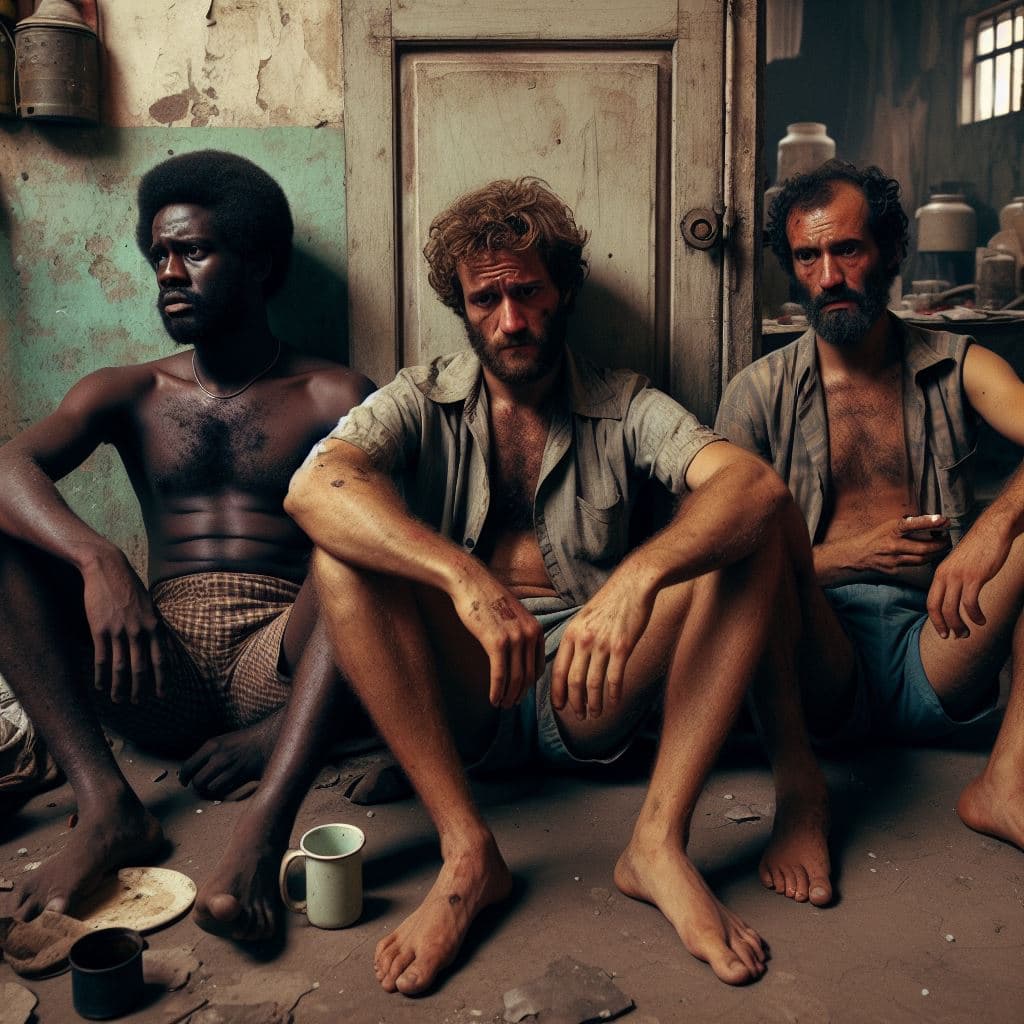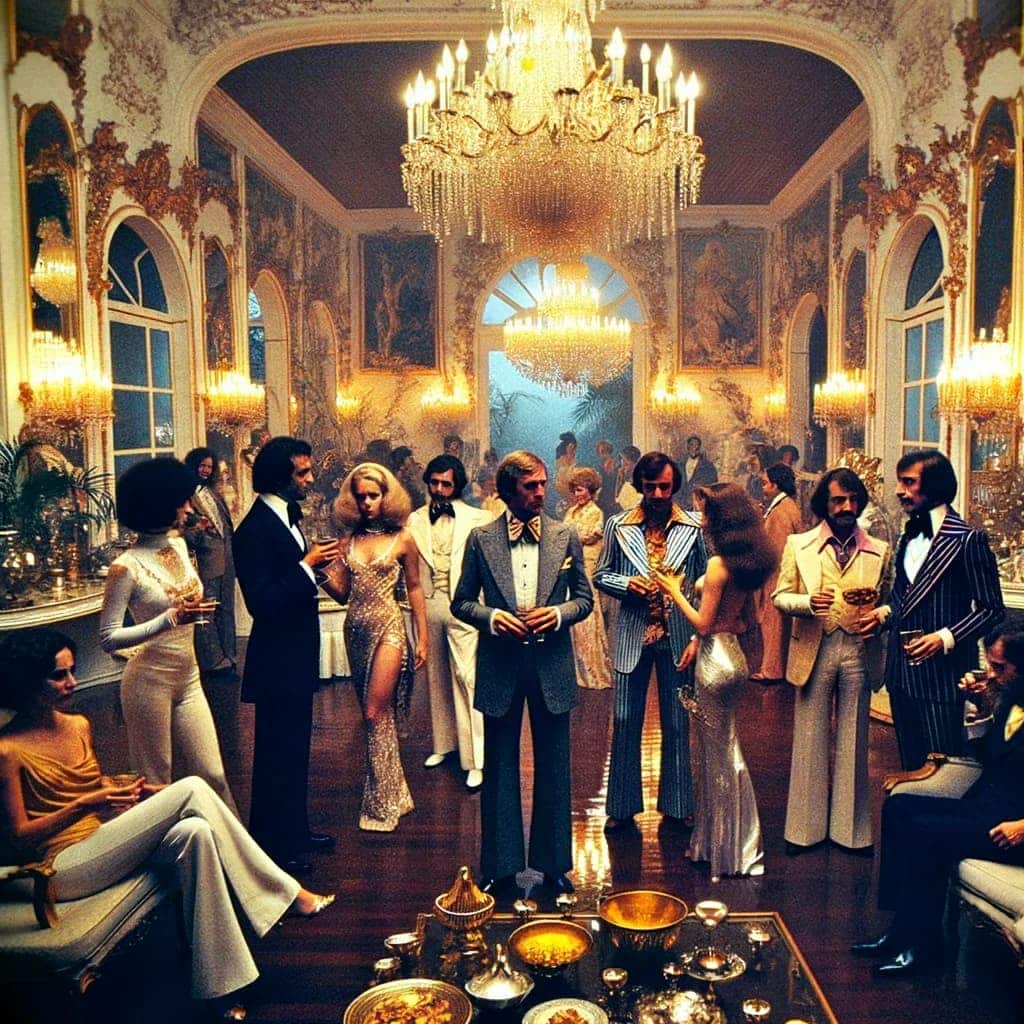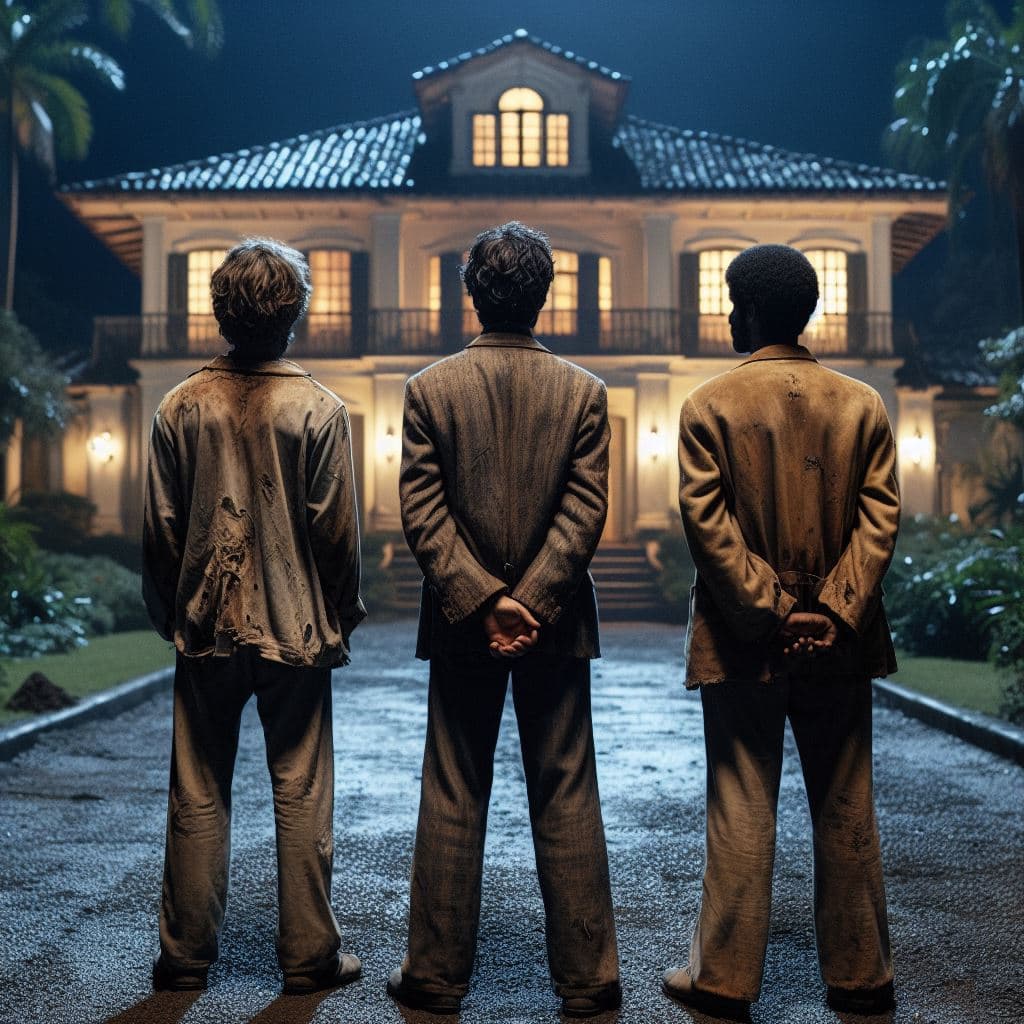Tabla de contenidos
Summary of “Happy New Year” (Feliz ano novo) by Rubem Fonseca
Rubem Fonseca’s short story “Happy New Year” (Feliz ano novo) is a work that immerses the reader in a stark urban reality, presenting a bleak portrait of Brazilian society in the mid-1970s. The story follows three main characters: Pereba, Zequinha, and the narrator, who are criminals marginalized by society and hardened by their circumstances.
The narrative begins on New Year’s Eve, with the characters watching on television as the wealthy prepare for the celebrations. Pereba and the narrator, from their humble abode, contemplate with disdain and resignation their situation of poverty and marginalization. Zequinha joins them, and together, they plan a desperate act to escape their misery: a robbery of a New Year’s Eve party at a wealthy home.
The robbery, executed with brutality and desperation, turns into a violent raid that illustrates the social gulf between the robbers and their victims. The criminals, armed and wearing stockings over their faces to conceal their identity, break into the party, subjecting the guests and employees to cruel and merciless treatment. The narrator describes in detail the process of the robbery, the violence exercised, and the looting of jewelry and money, presenting a scenario of horror and despair.
The story culminates with an act of extreme and symbolic violence: the narrator shoots one of the guests, thus showing the degree of alienation and dehumanization to which the characters have reached. The story ends with a sense of emptiness and desolation, leaving the reader with a reflection on deep social divisions and the brutality they can engender. “Happy New Year” is a work that challenges the reader to confront the reality of violence and inequality, presenting a disturbing portrait of Brazilian society at the time.
The characters and their development throughout the story.
In Rubem Fonseca’s “Happy New Year,” the main characters are Pereba, Zequinha, and the narrator, each with a distinctive development and personality throughout the story.
His rudeness and desperation characterize Pereba. He is impulsive and violent, showing little regard for the lives or welfare of others. Throughout the story, he is revealed as someone who dives into violence without restraint, being one of the most brutal protagonists of the assault. Pereba is the one who climbs up the ladder with one of the women in the house, showing his disposition to physical and sexual violence.
Zequinha, on the other hand, is the one who initially proposes the idea of the heist. He is shown as a cunning and calculating character but equally ruthless. During the robbery, Zequinha is in charge of tying up the victims and is the one who coldly executes one of the men during the robbery, demonstrating exceptional coldness and cruelty. In addition, Zequinha manages the situation with the narrator and Pereba, showing some leadership in the group.
The narrator, whose name is never mentioned, offers a more thoughtful and detailed perspective of the setting and actions. Despite his involvement in the crime, he shows certain glimmers of conscience, although this does not preclude his participation in the assault and acts of extreme violence. It is the narrator who describes in detail the process of the robbery, as well as his acts of violence, including the murder of a man during the theft.
The three characters reflect different facets of desperation and marginalization in an unequal society. Pereba and Zequinha embody brutality and cruelty, while the narrator offers a more introspective, yet equally disturbing, look at the criminal world in which they live. Throughout the story, these characters move through an environment of extreme poverty, making impulsive and violent decisions in their struggle to survive and gain wealth. The story ends with a sense of emptiness and desolation, highlighting the brutality of society and the profound social divisions that can lead to acts of extreme violence.

The scenario in which the story takes place
“Happy New Year” takes place in an urban setting, specifically in a Brazilian city that reflects the social tensions and inequalities of the time. The main scenarios of the story are:
The muggers’ apartment: The narrator and his companions, Pereba and Zequinha, begin the story in poverty and marginalization. The apartment where they find themselves is described as precarious, reflecting their difficult living conditions. This location serves as the starting point for the planning of the robbery and as a place of return after the theft, where the characters discuss and reflect on their actions.
The house that is robbed: The story’s central location is where the robbery occurs. This house, located in a wealthy neighborhood, symbolizes the contrast between wealth and poverty. The narrator describes the entrance to the house, which has a large garden and is isolated from the hustle and bustle of the street, indicating its opulence and isolation from the reality of the majority. Inside the house, the description of the living room, where the guests were drinking and dancing, and other details, such as the decoration and the wealth of the guests, contrast sharply with the setting of the assailants.
These settings are central to the narrative, as they provide the backdrop for the action and reinforce the themes of social inequality and violence central to the story. The contrast between the robbers’ apartment and the luxurious house underscores the divide between the rich and the poor, a recurring theme in Fonseca’s work. The tension and desperation of the characters are intensified by these settings, which are both physical and symbolic.
Writing techniques employed by Fonseca in “Happy New Year.”
First-person narrative: The story is narrated in the first person by one of the criminals, which provides an internal and direct perspective of the events. This choice allows intimate access to the character’s thoughts and emotions, intensifying the connection between the reader and the narrative.
Raw and direct language: Fonseca uses raw and direct language, reflecting the harshness of street life and the brutality of the characters. This unadorned style conveys the violence and despair more shockingly and realistically.
Detailed and vivid description: Detailed and graphic descriptions of settings and actions are a prominent feature of the story. Fonseca accurately describes the crime scenes, characters, and settings, enhancing realism and immersing the reader in the story.
Realistic dialogue: The dialogue in the story is realistic and reflects the everyday speech of the characters. This not only adds authenticity to the narrative but also reveals the personalities and relationships between the characters.
Use of explicit violence: Fonseca does not refrain from describing acts of violence explicitly. This technique underscores the rawness of the character’s lives and the brutality of their actions, generating a strong emotional impact on the reader.
Irony and sarcasm: The story uses irony and sarcasm, especially in the narrator’s dialogue and thoughts. This adds a layer of complexity to the narrative and often serves to underscore the social critique implicit in the story.

Narrative point of view
As noted above, in “Happy New Year,” the narrative point of view is in the first person, told by one of the delinquent protagonists of the story. This narrative approach immerses the reader in the narrator’s mind and experiences, allowing direct access to his thoughts, perceptions, and emotions.
Through the first person, the narrator offers an inside, personal view of events, including the planning and execution of the robbery, as well as his interactions with the other characters, Pereba and Zequinha. This point of view brings authenticity and depth to the story, as the reader not only observes the events from the external perspective but also experiences the story from the subjective perspective of the narrator.
Using the first person also facilitates a more intense and emotional narrative. By being directly inside the narrator’s head, readers witness his raw reflections, justifications, and interpretation of events. This is evident in the detailed descriptions of violent actions, dialogues with other characters, and reflections on the situation they find themselves in.
The first-person narrative point of view in “Happy New Year” is instrumental in conveying the story’s intensity, allowing the reader to understand the characters and their motivations. This approach helps create a more immersive and emotionally impactful narrative.
Main themes addressed in the story
Violence and brutality: The story is notable for its explicit and detailed depiction of violence. From the robbery to the characters’ interactions, brutality is a constant theme. Violence is presented not only as a tool to achieve an end (the theft) but also as an expression of the characters’ desperation and rage.
Social inequality: The contrast between the robbers’ poverty and the robbery victims’ wealth underscores the existing socioeconomic gap. The story shows how this inequality can lead to desperation and extreme acts, reflecting the social tensions in Brazilian society at the time.
Despair and marginalization: The main characters are portrayed as individuals marginalized by society, leading them to commit desperate acts. The story explores how lacking opportunities and marginalization can push people into crime.
Inhumanity and dehumanization: Throughout the story, we observe how the characters lose their humanity and become desensitized to violence and suffering. This is reflected in how they treat their victims and interactions, showing a deterioration of empathy and respect for human life.
These themes intertwine to create an intense and provocative story that offers a raw look at the reality of life on the margins of society and the extreme consequences of inequality and marginalization.
Historical and cultural context
“Happy New Year” by Rubem Fonseca is set in a specific historical and cultural context that significantly influences the narrative and themes of the story. The story takes place in Brazil, probably in Rio de Janeiro, during the 1970s, which were marked by profound social and political tensions. Some relevant aspects of this context include:
Military Dictatorship in Brazil (1964-1985): During this period, Brazil was under an authoritarian military regime that suppressed many civil liberties. This created a climate of fear and repression, which are reflected in the attitudes and actions of the characters in the story.
Social and economic inequality: The 1970s in Brazil were marked by significant social and economic inequality. The differences between rich and poor were extremely pronounced, reflected in the contrast between the characters’ lives in the story and the luxury of the robbery victims.
Violence and crime: Violence and crime were significant problems in urban areas of Brazil during this time. The story’s narrative, focusing on brutal violence and desperate crime, reflects these social conditions.
Culture and superstition: The story also references cultural and religious aspects of Brazil, such as beliefs in macumba and other Afro-Brazilian practices. These elements give context to the beliefs and behaviors of the characters, especially about superstition and religion.
This historical and cultural context is essential to understanding “Happy New Year,” as it provides the background against which the story’s events unfold and the characters’ lives are shaped. Fonseca’s story is not only a tale of crime and violence but also a commentary on Brazil’s social and political conditions during this turbulent period.

Conclusions or lessons that can be drawn from the story.
The story “Happy New Year” offers several important conclusions or lessons:
Consequences of Social Inequality: One of the most salient lessons of the story is the depiction of social inequality and its implications. The story shows how extreme poverty and exclusion can lead people to make desperate and violent decisions. This suggests reflecting on the need to address inequality to prevent such extremes.
Violence begets violence: The story also illustrates how violence can become a destructive cycle. The characters, marginalized and desperate, resort to violence as a means to survive. Still, this very violence perpetuates their alienation and despair, suggesting that violence is not a long-term solution to their problems.
Desensitization to cruelty: The narrative shows how people can become desensitized to extreme acts of cruelty and violence. Characters engage in brutal acts without showing remorse or empathy, reflecting a loss of humanity and sensitivity that can occur in extreme situations of survival and marginalization.
The complexity of human behavior: The story also highlights the complexity of human behavior. Through its characters and their actions, Fonseca explores the various facets of human nature, from brutality to survival, desperation to cynicism. This invites readers to consider the multiple dimensions of the human condition.
Reflection on justice and social order: The story also invites reflection on the concepts of justice and social order. Through the characters’ actions and interactions with society, Fonseca raises questions about what constitutes justice in a world marked by profound inequalities and what it means to maintain order in a society that often marginalizes the less fortunate.
5 reasons to read the story “Happy New Year” (Feliz ano novo) by Rubem Fonseca
1. The short story offers an intense and stark look at Brazil’s social and economic reality in the 1970s, marked by inequality and marginalization. The work allows readers to understand better the social and economic dynamics of this time and place, contributing to a greater understanding of persistent social problems.
2. Fonseca employs a raw, unadorned narrative style that immerses the reader in the story. This direct and realistic approach is effective in conveying the urgency and rawness of the characters’ experience, offering a powerful and emotional reading experience.
3. Through his characters and their actions, Fonseca explores the complexities of human nature. The story addresses themes of violence, despair, survival, and morality in extreme circumstances, inviting readers to reflect on these fundamental aspects of the human condition.
4. The work has a strong emotional impact and provokes the reader to think about challenging and complex issues. This makes it a meaningful read for those interested in understanding social realities through literature.
5. The story also functions as a social and political critique, highlighting the flaws and challenges of Brazilian society at the time. This critical dimension is valuable for readers interested in literature as a tool for social commentary.
